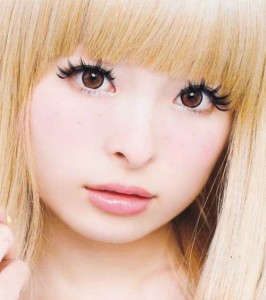Pop Music Album Review: Kyary Pamyu Pamyu’s “Nandacollection” — Blissful Bubblegum
Every moment of Kyary Pamyu Pamyu’s album Nandacollection exudes bliss and is a blast to listen to. It is bubblegum with more than a touch of brilliance.
Dismissing the music of J-pop artist Kyary Pamyu Pamyu is incredibly tempting. Kyary’s audacious fashion sense and the bizarre visual aesthetic of her music videos have earned her the title of “Harajuku Pop Princess” in her native Japan.
In the West, her dadaesque style has earned her the title of “Japan’s Lady Gaga.” This parallel isn’t entirely inaccurate—Kyary names Lady Gaga as a major visual and musical inspiration. But the labeling has led Westerners to develop preconceived (belittling) notions about Kyrary and her music. Lady Gaga has mainstream appeal and is loved by many, but those who keep their ears attuned to the sounds of the underground see her music as trashy, vapid radio pop marketed via a persona of faux-eccentricity. Lady Gaga’s weirdness is superficial; it’s a put on; it doesn’t find its way into the music in a meaningful way.
And that is just where comparisons between Kyary and Lady Gaga falter. Kyary’s dedication to strangeness actually makes its way into her music, resulting in pop tunes that are refreshingly and sincerely weird to Western ears. This is particularly true of her sophomore LP, Nandacollection, which has no shortage of catchy hooks, zany rhythms, and sugary synths.
What Kyary is doing with her art isn’t exactly commonplace in her native Japan, either. She has enlisted Yasutaka Nakata (of indietronic group Capsule) as producer to help her craft some truly baffling synthpop landscapes to backdrop her typically youthful vocals. This collaboration proves to be fruitful immediately with the 50-second-long title track. The piece boasts exotic wooden percussion, a toy piano texture, what sounds to be a bagpipe, and tinny chants from Kyary. It’s incredibly bouncy and fun but also manages to be kind of outlandishly “epic” despite its brevity.
The following song, “Ninjya Re Bang Bang,” is one of the disc’s many proficient pop songs. This tune’s chorus is so infectious that not even the language barrier will stop it from becoming stuck in the heads of listeners, Western or otherwise. There are elements of chiptune in this track, but the beat again sounds extremely exotic, with what might be wooden blocks clanking in the background, as well as a kooky katana sound effect.
This leads into “Kimi ni 100 Percent,” which wouldn’t sound horribly out of place if it were on a Deerhoof record. The timbre of Kyary’s voice is similar to that of Deerhoof’s Satomi Matsuzaki, but the driving, clap-heavy drum machine beat and light synth work is reminiscent of last year’s Breakup Song. Kyary’s inflexion on this track is stellar—you can’t help but bop your head from side-to-side while she’s singing. The result is another earwormy pop ditty.
But the earwormiest moment on the album comes with the single “Invader Invader.” The choruses are barrages of wonky chiptune and electropop synths, robotic sound effects, and zany vocal melodies that give way to delicate, exquisite verses. After the second chorus, a dubstep drop happens, an act that many critically eared Westerners believe to be the greatest offense in popular music. However, it’s done in such an agile way that it doesn’t reek of Kyary trying to appeal to the “dubstep demographic.” Because the drop goes over well, it adds an element of surprise to the tried-and-true pop song structure. The tune comes across as buoyant with a welcome accent of self-awareness.
“Mi”’s vocal melody is ridiculously infectious—Kyary simply chants the title lyric ad nauseam over a multi-phased beat. On “Fashion Monster” the rapid snare, in tandem with the inflexion and pitch of Kyary’s voice, is enough to make one’s heart swell, again in a way reminiscent of Deerhoof. All 12 tracks are also accented by some truly eccentric, often unidentifiable or surprising instrumentation—an instance of the latter is the tuba on “Kura Kura,” the penultimate tune.
Perhaps the only example of a tune skirting the lackluster is “Super Scooter Happy,” which is a Capsule cover. Because Kyary is such a charming vocalist it’s a likable enough effort, but the production here is just run-of-the-mill compared to other sonic juggling acts on the album.
Yasutaka Nakata has really outdone himself with the overall production of this LP. Every tune is layered to the brim with skittering electronics, but the mix is clean, the music’s various textures coming through detailed and clear. Even more impressive is his ability to provide such bright aural surfaces without making the project feel nauseatingly sanitized, as so much pop music sadly is.
Kyary is making pop music the right way—creating tunes that are worthwhile on their own entertaining terms. She is leagues ahead of not only her Western contemporaries but her Japanese competitors as well. Unfortunately, there is a stigma associated with pop music in this country: it’s a genre perceived by many to be vulgar, shallow, insincere, etc. Even those with an open mind may find Nandacollection to be “sickeningly sweet.” Still, this is bubblegum with a touch of brilliance, easily one of the most well-produced, consistently catchy, and adventurous pop records around.
Tagged: bubblegum, japanese pop, Kyary Pamyu Pamyu, Nandacollection



super happy to see an american review of kyary…..minor quibbles about the album aside [the last track is in the wrong place] song for song it’s brilliant and varied….nakata moving into revolver territory
this is year thirteen of nakata releasing commercial music and it’s a fantastic album…[i’m hardpressed to think of anyone operating at this level at this point in their career]…..it also reinforces my opinion that he’s the best pop songwriter in the world